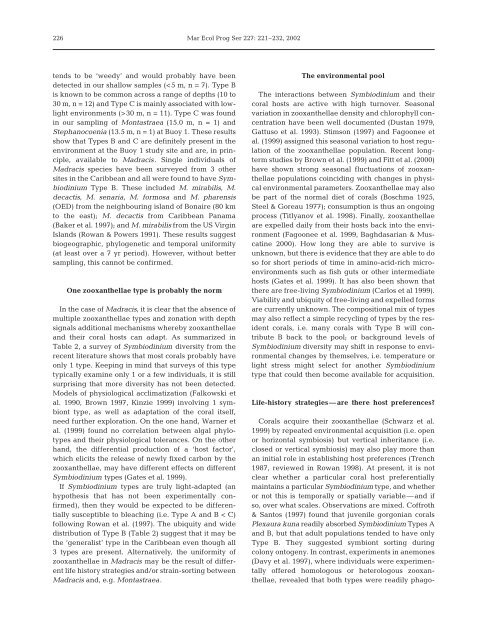No habitat correlation of zooxanthellae in the coral ... - Inter Research
No habitat correlation of zooxanthellae in the coral ... - Inter Research
No habitat correlation of zooxanthellae in the coral ... - Inter Research
Create successful ePaper yourself
Turn your PDF publications into a flip-book with our unique Google optimized e-Paper software.
226<br />
tends to be ‘weedy’ and would probably have been<br />
detected <strong>in</strong> our shallow samples (30 m, n = 11). Type C was found<br />
<strong>in</strong> our sampl<strong>in</strong>g <strong>of</strong> Montastraea (15.0 m, n = 1) and<br />
Stephanocoenia (13.5 m, n = 1) at Buoy 1. These results<br />
show that Types B and C are def<strong>in</strong>itely present <strong>in</strong> <strong>the</strong><br />
environment at <strong>the</strong> Buoy 1 study site and are, <strong>in</strong> pr<strong>in</strong>ciple,<br />
available to Madracis. S<strong>in</strong>gle <strong>in</strong>dividuals <strong>of</strong><br />
Madracis species have been surveyed from 3 o<strong>the</strong>r<br />
sites <strong>in</strong> <strong>the</strong> Caribbean and all were found to have Symbiod<strong>in</strong>ium<br />
Type B. These <strong>in</strong>cluded M. mirabilis, M.<br />
decactis, M. senaria, M. formosa and M. pharensis<br />
(OED) from <strong>the</strong> neighbour<strong>in</strong>g island <strong>of</strong> Bonaire (80 km<br />
to <strong>the</strong> east); M. decactis from Caribbean Panama<br />
(Baker et al. 1997); and M. mirabilis from <strong>the</strong> US Virg<strong>in</strong><br />
Islands (Rowan & Powers 1991). These results suggest<br />
biogeographic, phylogenetic and temporal uniformity<br />
(at least over a 7 yr period). However, without better<br />
sampl<strong>in</strong>g, this cannot be confirmed.<br />
One <strong>zooxan<strong>the</strong>llae</strong> type is probably <strong>the</strong> norm<br />
In <strong>the</strong> case <strong>of</strong> Madracis, it is clear that <strong>the</strong> absence <strong>of</strong><br />
multiple <strong>zooxan<strong>the</strong>llae</strong> types and zonation with depth<br />
signals additional mechanisms whereby <strong>zooxan<strong>the</strong>llae</strong><br />
and <strong>the</strong>ir <strong>coral</strong> hosts can adapt. As summarized <strong>in</strong><br />
Table 2, a survey <strong>of</strong> Symbiod<strong>in</strong>ium diversity from <strong>the</strong><br />
recent literature shows that most <strong>coral</strong>s probably have<br />
only 1 type. Keep<strong>in</strong>g <strong>in</strong> m<strong>in</strong>d that surveys <strong>of</strong> this type<br />
typically exam<strong>in</strong>e only 1 or a few <strong>in</strong>dividuals, it is still<br />
surpris<strong>in</strong>g that more diversity has not been detected.<br />
Models <strong>of</strong> physiological acclimatization (Falkowski et<br />
al. 1990, Brown 1997, K<strong>in</strong>zie 1999) <strong>in</strong>volv<strong>in</strong>g 1 symbiont<br />
type, as well as adaptation <strong>of</strong> <strong>the</strong> <strong>coral</strong> itself,<br />
need fur<strong>the</strong>r exploration. On <strong>the</strong> one hand, Warner et<br />
al. (1999) found no <strong>correlation</strong> between algal phylotypes<br />
and <strong>the</strong>ir physiological tolerances. On <strong>the</strong> o<strong>the</strong>r<br />
hand, <strong>the</strong> differential production <strong>of</strong> a ‘host factor’,<br />
which elicits <strong>the</strong> release <strong>of</strong> newly fixed carbon by <strong>the</strong><br />
<strong>zooxan<strong>the</strong>llae</strong>, may have different effects on different<br />
Symbiod<strong>in</strong>ium types (Gates et al. 1999).<br />
If Symbiod<strong>in</strong>ium types are truly light-adapted (an<br />
hypo<strong>the</strong>sis that has not been experimentally confirmed),<br />
<strong>the</strong>n <strong>the</strong>y would be expected to be differentially<br />
susceptible to bleach<strong>in</strong>g (i.e. Type A and B < C)<br />
follow<strong>in</strong>g Rowan et al. (1997). The ubiquity and wide<br />
distribution <strong>of</strong> Type B (Table 2) suggest that it may be<br />
<strong>the</strong> ‘generalist’ type <strong>in</strong> <strong>the</strong> Caribbean even though all<br />
3 types are present. Alternatively, <strong>the</strong> uniformity <strong>of</strong><br />
<strong>zooxan<strong>the</strong>llae</strong> <strong>in</strong> Madracis may be <strong>the</strong> result <strong>of</strong> different<br />
life history strategies and/or stra<strong>in</strong>-sort<strong>in</strong>g between<br />
Madracis and, e.g. Montastraea.<br />
Mar Ecol Prog Ser 227: 221–232, 2002<br />
The environmental pool<br />
The <strong>in</strong>teractions between Symbiod<strong>in</strong>ium and <strong>the</strong>ir<br />
<strong>coral</strong> hosts are active with high turnover. Seasonal<br />
variation <strong>in</strong> <strong>zooxan<strong>the</strong>llae</strong> density and chlorophyll concentration<br />
have been well documented (Dustan 1979,<br />
Gattuso et al. 1993). Stimson (1997) and Fagoonee et<br />
al. (1999) assigned this seasonal variation to host regulation<br />
<strong>of</strong> <strong>the</strong> <strong>zooxan<strong>the</strong>llae</strong> population. Recent longterm<br />
studies by Brown et al. (1999) and Fitt et al. (2000)<br />
have shown strong seasonal fluctuations <strong>of</strong> <strong>zooxan<strong>the</strong>llae</strong><br />
populations co<strong>in</strong>cid<strong>in</strong>g with changes <strong>in</strong> physical<br />
environmental parameters. Zooxan<strong>the</strong>llae may also<br />
be part <strong>of</strong> <strong>the</strong> normal diet <strong>of</strong> <strong>coral</strong>s (Boschma 1925,<br />
Steel & Goreau 1977); consumption is thus an ongo<strong>in</strong>g<br />
process (Titlyanov et al. 1998). F<strong>in</strong>ally, <strong>zooxan<strong>the</strong>llae</strong><br />
are expelled daily from <strong>the</strong>ir hosts back <strong>in</strong>to <strong>the</strong> environment<br />
(Fagoonee et al. 1999, Baghdasarian & Muscat<strong>in</strong>e<br />
2000). How long <strong>the</strong>y are able to survive is<br />
unknown, but <strong>the</strong>re is evidence that <strong>the</strong>y are able to do<br />
so for short periods <strong>of</strong> time <strong>in</strong> am<strong>in</strong>o-acid-rich microenvironments<br />
such as fish guts or o<strong>the</strong>r <strong>in</strong>termediate<br />
hosts (Gates et al. 1999). It has also been shown that<br />
<strong>the</strong>re are free-liv<strong>in</strong>g Symbiod<strong>in</strong>ium (Carlos et al 1999).<br />
Viability and ubiquity <strong>of</strong> free-liv<strong>in</strong>g and expelled forms<br />
are currently unknown. The compositional mix <strong>of</strong> types<br />
may also reflect a simple recycl<strong>in</strong>g <strong>of</strong> types by <strong>the</strong> resident<br />
<strong>coral</strong>s, i.e. many <strong>coral</strong>s with Type B will contribute<br />
B back to <strong>the</strong> pool; or background levels <strong>of</strong><br />
Symbiod<strong>in</strong>ium diversity may shift <strong>in</strong> response to environmental<br />
changes by <strong>the</strong>mselves, i.e. temperature or<br />
light stress might select for ano<strong>the</strong>r Symbiod<strong>in</strong>ium<br />
type that could <strong>the</strong>n become available for acquisition.<br />
Life-history strategies—are <strong>the</strong>re host preferences?<br />
Corals acquire <strong>the</strong>ir <strong>zooxan<strong>the</strong>llae</strong> (Schwarz et al.<br />
1999) by repeated environmental acquisition (i.e. open<br />
or horizontal symbiosis) but vertical <strong>in</strong>heritance (i.e.<br />
closed or vertical symbiosis) may also play more than<br />
an <strong>in</strong>itial role <strong>in</strong> establish<strong>in</strong>g host preferences (Trench<br />
1987, reviewed <strong>in</strong> Rowan 1998). At present, it is not<br />
clear whe<strong>the</strong>r a particular <strong>coral</strong> host preferentially<br />
ma<strong>in</strong>ta<strong>in</strong>s a particular Symbiod<strong>in</strong>ium type, and whe<strong>the</strong>r<br />
or not this is temporally or spatially variable—and if<br />
so, over what scales. Observations are mixed. C<strong>of</strong>froth<br />
& Santos (1997) found that juvenile gorgonian <strong>coral</strong>s<br />
Plexaura kuna readily absorbed Symbiod<strong>in</strong>ium Types A<br />
and B, but that adult populations tended to have only<br />
Type B. They suggested symbiont sort<strong>in</strong>g dur<strong>in</strong>g<br />
colony ontogeny. In contrast, experiments <strong>in</strong> anemones<br />
(Davy et al. 1997), where <strong>in</strong>dividuals were experimentally<br />
<strong>of</strong>fered homologous or heterologous <strong>zooxan<strong>the</strong>llae</strong>,<br />
revealed that both types were readily phago-

















